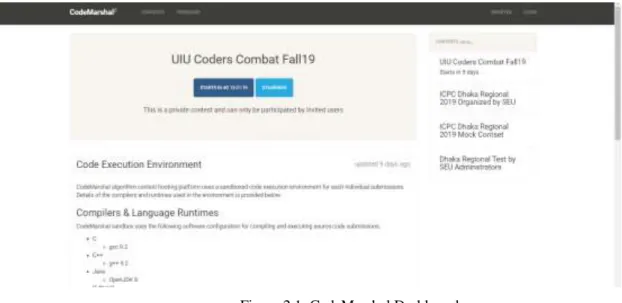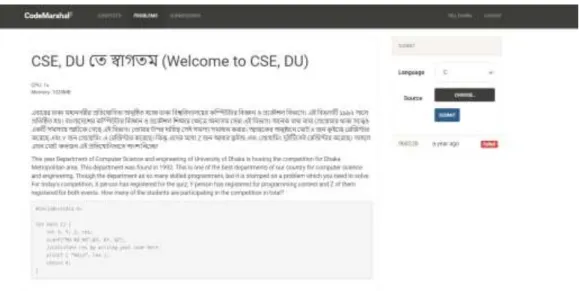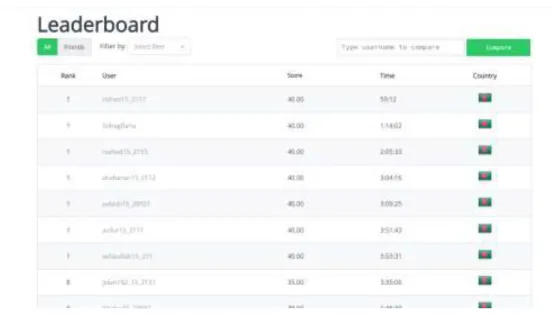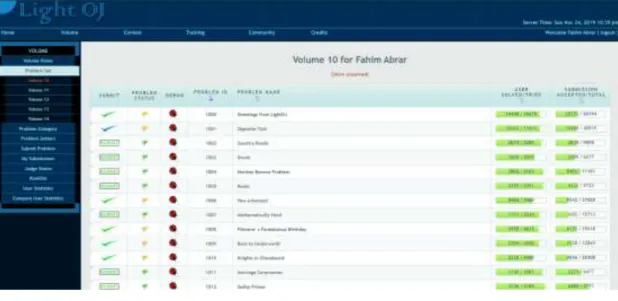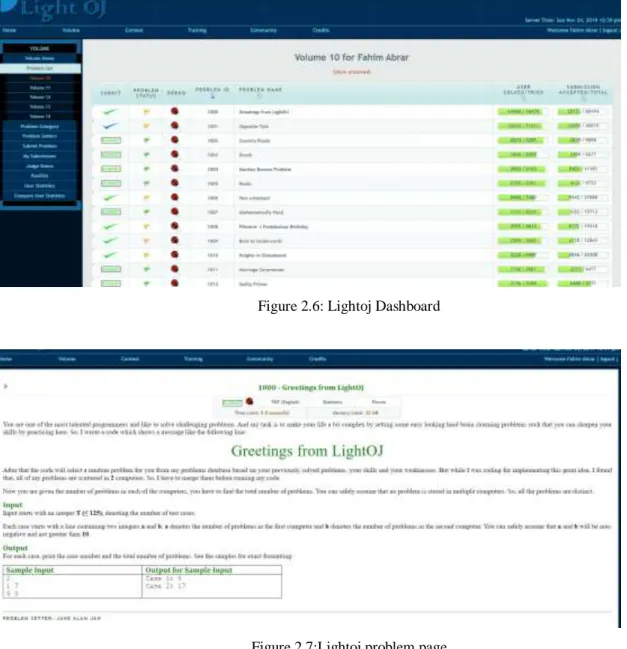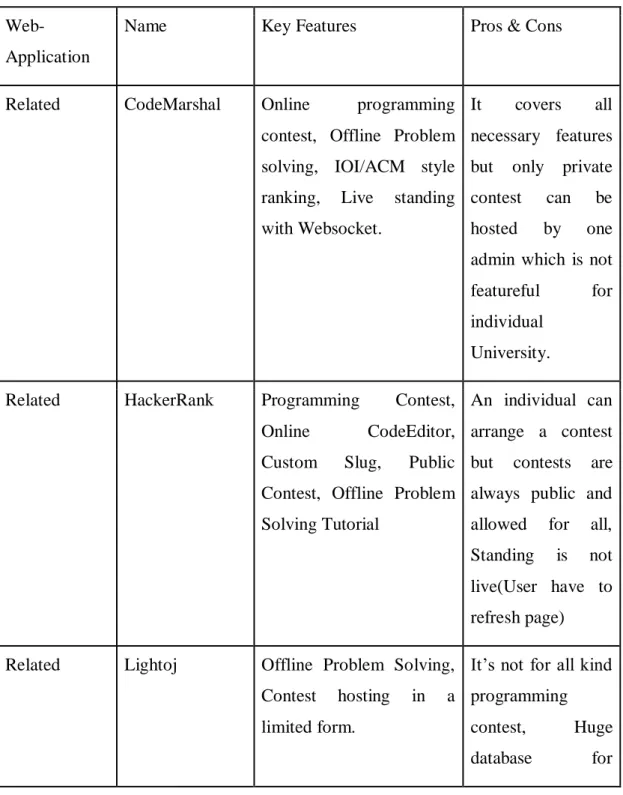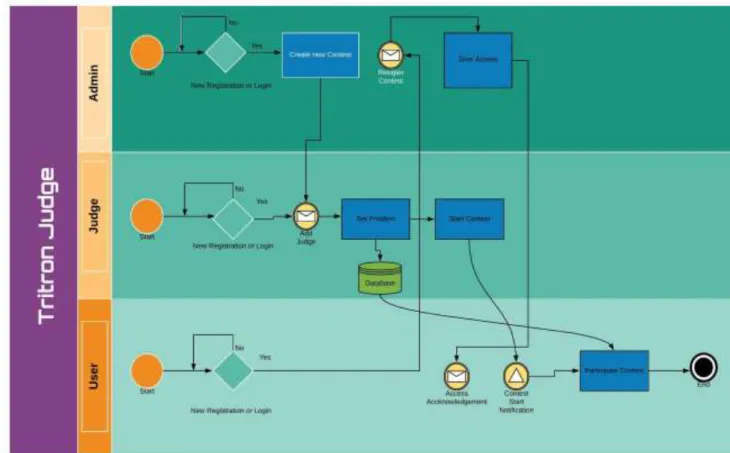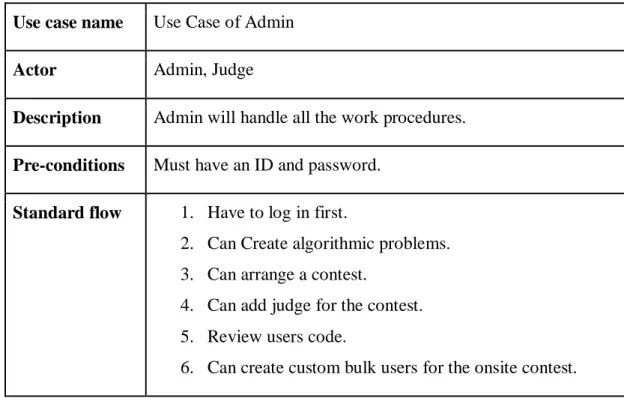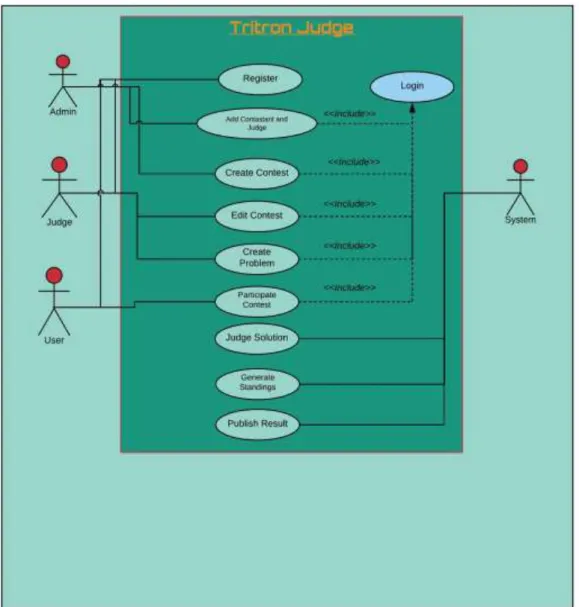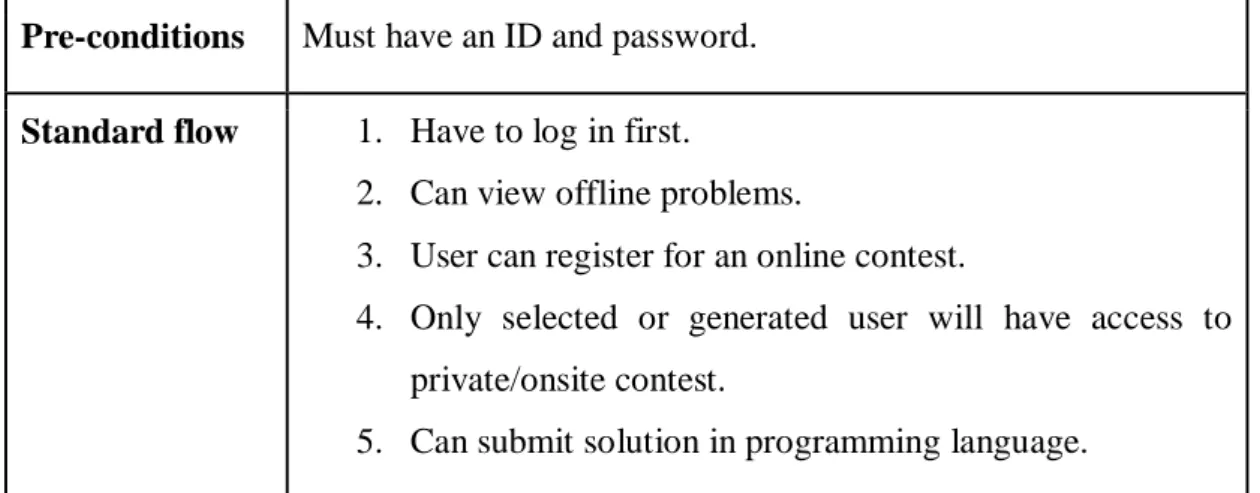©Daffodil International University TRITRON ONLINE JUDGE
BY
Syed Mohammad Fahim Abrar ID: 161-15-903
AND
Md Razibul Hasan Mithu ID: 161-15-882
AND
Mohammad Shakil Mahmud ID: 161-15-884
This Report Presented in Partial Fulfillment of the Requirements for the Degree of Bachelor of Science in Computer Science and Engineering
Supervised by
PROF. DR. SYED AKHTER HOSSAIN
HeadDepartment of CSE
Daffodil International University
DAFFODIL INTERNATIONAL UNIVERSITY DHAKA, BANGLADESH
DECEMBER 2019
©Daffodil International University
ii
APPROVAL
This project titled “Tritron Online Judge”, submitted by Syed Mohammad Fahim Abrar,Id:161- 15-903, Md. Razibul Hasan Mithu,Id:161-15-882 and Mohammad Shakil Mahmud, Id:161-15- 884 to the Department of Computer Science and Engineering, Daffodil International University, has been accepted as satisfactory for the partial fulfilment of the requirements for the degree of B.Sc. in Computer Science and Engineering and approved as to its style and contents. The presentation has been held on December, 2019.
BOARD OF EXAMINERS
Dr. Syed Akhter Hossain Chairman
Professor and Head
Department of Computer Science and Engineering Faculty of Science & Information Technology Daffodil International University
Dr. S M Aminul Haque Internal Examiner
Associate Professor & Associate Head
Department of Computer Science and Engineering Faculty of Science & Information Technology Daffodil International University
Saif Mahmud Parvez Internal Examiner
Lecturer
Department of Computer Science and Engineering Faculty of Science & Information Technology Daffodil International University
Dr. Mohammad Shorif Uddin External Examiner
Professor
Department of Computer Science and Engineering Jahangirnagar University
DECLARATION
©Daffodil International University
iii
We hereby declare that this project has been done by us under the supervision of Prof. Dr. Syed Akhter Hossain, Head, Department of CSE Daffodil International University. We also declare that neither this project nor any part of this project has been submitted elsewhere for the award of any degree or diploma.
Supervised by:
____________________________
Prof. Dr. Syed Akhter Hossain Head
Department of CSE
Daffodil International University
Submitted by:
____________________________
Syed Mohammad Fahim Abrar ID: 161-15-903
Department of CSE
Daffodil International University
____________________________
Md Razibul Hasan Mithu ID: 161-15-882
Department of CSE
Daffodil International University
____________________________
Mohammad Shakil Mahmud ID: 161-15-884
Department of CSE
Daffodil International University
©Daffodil International University
iv
ACKNOWLEDGEMENT
First, we express our heartiest thanks and gratitude to almighty God for His divine blessing makes us possible to complete the final year project successfully.
We really grateful and wish our profound our indebtedness to Prof. Dr Syed Akhter Hossain, Head, Department of CSE Daffodil International University, Dhaka. Deep Knowledge & keen interest of our supervisor in the field of web development to carry out this project. His endless patience, scholarly guidance, continual encouragement, constant and energetic supervision, constructive criticism, valuable advice, reading many inferior drafts and correcting them at all stages have made it possible to complete this project.
We would like to express our heartiest gratitude to Allah and also thankful to Mr Jalal Uddin, CEO, Devskill.com, for his kind help to give us a proper understanding of Asp.net MVC 5 to finish our project. Thanks to Zulkernine Mahmud, Software Engineer, Google to help us through proper guidance to understand multithreaded programming and Object-Oriented programming. We are also really grateful to Dr S M Aminul Hauque to give us the opportunity to host 3 Take off Programming contest and some Lab finals to prove “Tritron Online Judge” a robust system.
Thanks to stack overflow community to help us by giving answers to our specific problems.
Special thanks to MoshFegh Hamedani to keep us enlighten about clean code, clean architecture and Object-Oriented Design patterns to keep the system scalable and maintainable through his online courses in pluralsight.
We would like to thank our entire programming community of Daffodil International University who contributed to testing Tritron Online Judge by attending the programming contests.
Finally, we must acknowledge with due respect the constant support and patience of our parents.
©Daffodil International University
v
ABSTRACT
Tritron Online Judge is an automated code judging solution. It can automate the process of checking individuals code against a set of input-output with the generated output while executing the code. Without any doubt, it will add a huge advantage in evaluating student’s code in academic purpose. The automatic environment will save the time of professors on the other hand students will able to evaluate themselves immediately from the verdict of the automated judge. This will increase the algorithmic skills of students. Professor will introduce to problem settings in a professional platform, as a result, a talent problem setter community will grow. The automated judge will very cost and time-efficient for both academic and industrial purpose. The industry will be able to pre-evaluate the candidates by taking an online test of them. The endless opportunity of Tritron Online Judge makes it a great ever project.
©Daffodil International University
vi
TABLE OF CONTENTS
CONTENTS
PAGEBoard of Examiners i
Approval ii
Declaration iii
Acknowledgement iv
Abstract v
List of Figure viii
List of Tables ix
CHAPTER
CHAPTER 1: INTRODUCTION 10
1.1 Introduction 10
1.2 Motivation 10
1.3 Objectives 11
1.4 Expected Outcome 12
1.5 Report Layout 13
CHAPTER 2: BACKGROUND 15
2.1 Introduction 15
2.2 Related Works 15
2.3 Comparative Studies 19
2.4 Scope of the Problem 20
2.5 Challenges 20
CHAPTER 3: REQUIREMENT SPECIFICATION 22
3.1 Business Process Modeling 22
3.2 Requirement Collection and Analysis 22
3.3 Use Case Modeling and Description 23
3.4 Logical Data Model 25
3.5 Design Requirements 28
©Daffodil International University
vii
CHAPTER 4: DESIGN SPECIFICATION 19
4.1 Front-end Design 29
4.2 Back-end Design 30
4.3 Interaction Design and UX 31
4.4 Implementation Requirements 34
CHAPTER 5: IMPLEMENTATION AND TESTING 36
5.1 Implementation of Class Diagram 36
5.2 Implementation of Front-end Design 38
5.3 Implementation of Interactions 38
5.4 Testing Implementation 38
5.5 Test Results and Reports 40
CHAPTER 6: CONCLUSION AND FUTURE SCOPE 44
6.1 Discussion and Conclusion 44
6.2 Scope for Further Developments 44
APPENDIX
44Appendix A: Project Reflection 45
REFERENCES
46©Daffodil International University
viii
LIST OF FIGURES
FIGURE PAGE
Figure 2.1: CodeMarshal Dashboard 15
Figure 2.2: CodeMarshal Problem Page 16
Figure 2.3: CodeMarshal Standing 16
Figure 2.4: HackerRank Dashboard 17
Figure 2.5: HackerRank LeaderBoard 17
Figure 2.6: Lightoj Dashboard 18
Figure 2.7: Lightoj Problem Page 18
Figure 2.8: Lightoj Submission Page 18
Figure 2.9: Sandboxing 21
Figure 3.1: Business Process Modeling 21
Figure 3.2: Use case of Tritron Online Judge 24
Figure 3.3: Entity Relationship Diagram 26
Figure 3.4: Logical Schema 27
Figure 3.5: Data Flow Diagram 28
Figure 4.1: Register Page 31
Figure 4.2: Login Page 31
Figure 4.3: Dashboard Page 32
Figure 4.4: Create Contest Page 32
Figure 4.5: All Contests Page 32
Figure 4.6: Live Standing Page 33
Figure 4.7: Submissions in contest page 33
Figure 4.8: Submissions view in modal 34
Figure 4.9: Problem view page 34
Figure 5.1: Business Logic class Diagram 36
Figure 5.2: Repository Class Diagram 37
LIST OF TABLES
©Daffodil International University
ix
TABLES PAGE
Table 2.1: Comparative Studies 19
Table 3.1: Use Case of Admin 23
Table 3.2: Use Case of User 25
Table 5.1: Testing Implementation 38
Table 5.2: Test the site Navigation 40
Table 5.3: Test the Content 41
Table 5.4: Application 41
Table 5.5: Database Server 42
Table 5.6: Database Testing 42
Table 5.7: Crowd Testing 43
©Daffodil International University
1
CHAPTER 1 INTRODUCTION
1.1 Introduction
Online Judge is a virtual automatic judge where some mathematical or algorithmic problem set will be given by a judging panel. And an individual can solve and verify their problem by submitting the solution code in some common programming language such as cplusplus, etc.and The verify process will be based on an input-output model, where some output will be generated against some input and users code will be compiled and injected by the judge’s input. If the output for the injected input is similar, then it will be an accepted solution and otherwise, it will be marked with some other verdicts. Based on these verdicts online judge can give a time based marking to the participant students and thus an online programming contest can be held.
1.2 Motivation
The typical issues of manual judging of lab performance of students, for example, in traditional way lab instructors have to collect code from all computers from lab manually in storage devices ,then have to go through all the students code manually compiling them and giving input in a console and observing output of the code and judge them if the output was correct. Collecting code itself is a lengthy process then compiling one by one and judge them manually is a painful and brainstorming time killing job.
Another factor is that in this way students are bound to submit one code script for each question only. And there was no opportunity to know if their code was right or wrong in real-time. They have only the opportunity to know the final grade when the final result is published. There was no way to practice the questions later after lab evaluation finished. But solving after the exam is the most important factor to sharpen algorithmic knowledge and correction of their common mistakes.
In another way, in the traditional system, there is no advantage of doing some code rightly before other participants of the evaluation exam. But evaluation should not be the same for two students who submitted there code rightly in a time difference.
©Daffodil International University
2
Rejudging is another big issue under the hood. Because if some instructor found that there was something dissimilarity with his questions and input-output checker data, even if he makes correction of his question again then it will be a painstaking process to rejudge the code.
So an automatic judge can take care of these issues easily and add more undeniable and powerful features.
1.3 Objectives
Our intention is to make a modern, automatic and user-friendly judging system where students will be assured if their code scripts were correct enough. It is a fairly judging process without thinking about code collecting, compiling and running by the instructor. Our judging platform will be time and cost-efficient and need less manpower to conduct any kinds of judgment at any time. Our key objectives are given below.
● Paperless exam for lab evaluation of programming and algorithmic courses.
● Time-efficient lab evaluation system.
● Realtime verdict for students code.
● Realtime rank list based on a timely fashion.
● Unlimited submission for single question script.
● Opportunity to observe previously submitted code.
● Practice offline problem-solving.
● Introducing students to programming content and online judges.
● Reduce manpower for arranging programming lab evaluation.
● Reducing human error in judging answer scripts.
● The easy rejudging system if there is a question error.
1.4 Expected Outcome
Cut down lab evaluation preparation time, logistical expenses and error-free judging platform.
1.4.1 Simple Question Setting
There will be a wysiwyg[1] editor to produce a document format of an algorithmic question, which will contain question description, input-output format, constraints of the input-output test data and lastly the sample of input-output set. There will be a file upload option to set the hidden input- output test case by which the students’ code will be evaluated.
©Daffodil International University
3 1.4.2 Varied Information Representation
Printed materials can not just suit various sorts of media. With paperless evaluation arrangements, there are huge opportunities. Non-text or graphic information, for example, audio and video can be effectively incorporated into question description. As it is very human-friendly to understand a pictorial or graphic format than the paper description it will be very handy and efficient to describe the algorithmic challenge to students.
1.4.3 Efficiency Gains
As there is no code collection portion from desk to desk of the lab, so it will be very time efficient.
There is no chance to make a human error while testing input-output with judges output. The real- time verdict will help students to instantly know about their code error. And they can submit unlimited solutions for each question as the automatic judger will judge their code in a moment of eyewink.
1.4.4 Automatic Ranking
In the old school way, there was no tracking option that which student submit the accepted code in which moment. So there was no option to compare with the equally solved participant. But our system keeps track with time stamp with code submission. So we can generate a ranking table with how many tries student solved the problem and who did it fast.
1.4.5 Dynamic Rejudging
All the submissions are saved in the database with a timestamp. So rejudging the code and update rank table is just a matter of a little time. If the instructor do some mistake with making the question set or input-output set, in any time they can correct it and rejudge.
1.4.6 Cost Efficiency
With ending the lab session the final rank will publish immediately, so there is no need of manpower and time to evaluate it. Even student can also observe it with after ending the session.
So it is very cost-effective as there is no need for extra examiner with an increment of the students.
1.5 Report Layout
©Daffodil International University
4
We designed this “Tritron Online Judge” project report on the basis of six layouts. All of them are discussed below.
1.5.1 First Layout
Introduction, Motivation, Objectives and expected outcomes all these four themes are discussed in this layout.
1.5.2 Second Layout
This design explores the context of the web application, comparative studies, the nature of the issues, challenges of all these five topics.
1.5.3 Third Layout
This layout discusses business processing model, requirements, case modelling, logical data model and description of all these five topics.
1.5.4 Fourth Layout
In this format, Front & Back End development, interface and UX design, implementation specifications are addressed.
1.5.5 Fifth Layout
Implementations of Database, Front-end interactions, test output and reports all these five themes are discussed in this layout.
1.5.6 Sixth Layout
Conclusion, Discussion and scope for future work are discussed in this layout.
©Daffodil International University
5
CHAPTER 2 BACKGROUND
2.1 Introduction
In this digital era, most of the IT/CS departments of numerous universities still go with conventional manual lab evaluation exam with manually judging students code in a compiler after collecting them from desk to desk. The idea of evaluating lab code with an automated judge did not pop out of anywhere suddenly. sports programming is known to the world from decades ago.
But applying sports programming like environment in grade school’s lab evaluation will add huge advantage in growing student’s algorithmic skill and also help professors to evaluate his student easily.
Our online judge application can be used as the sports programming platform, algorithmic skill development platform, lab evaluation platform and many more.
2.2 Related Works
2.2.1 CodeMarshal
Codemarshal[1] is a contest management system widely used in programming contest like ACM- ICPC or IOI in Bangladesh. The software was built for non-profit purpose. But private contest like taking a lab final of a university is rarely allowed. All kinds of admin interaction are only limited by the site owner.
Figure 2.1: CodeMarshal Dashboard
©Daffodil International University
6 Figure 2.2: CodeMarshal Problem Page
Figure 2.3: CodeMarshal Standing
2.2.2 HackerRank
HackerRank[2] is an Indian algorithmic problem practice website. It has an algorithmic problem practising arena and public contest arranging feature. But no private contest is allowed.
It can host only contest with IOI style leaderboard.
Related Image:
©Daffodil International University
7
Figure 2.4:
Hackerrank Dashboard
Figure 2.5: Hackerank LeaderBoard
2.2.3 LightOJ
Lightoj[3] is a Bangladeshi Online judge with numerous featureful problem that are useful to learn problem-solving. Having solved count in this OJ is an advantage on the Bangladeshi job market.
Though it has not enough powerfull contest service as others.
©Daffodil International University
8 Figure 2.6: Lightoj Dashboard
Figure 2.7:Lightoj problem page
Figure 2.7:Lightoj Submission page
©Daffodil International University
9
2.3 Comparative Studies
We have analyzed some of the similar online judges. They have some awesome page but not in one package. We gained ideas about how to integrate the crucial features all in one package in our online judge as an enterprise application.
Table 2.1: Comparative Studies
Web- Application
Name Key Features Pros & Cons
Related CodeMarshal Online programming contest, Offline Problem solving, IOI/ACM style ranking, Live standing with Websocket.
It covers all necessary features but only private contest can be hosted by one admin which is not featureful for individual
University.
Related HackerRank Programming Contest, Online CodeEditor, Custom Slug, Public Contest, Offline Problem Solving Tutorial
An individual can arrange a contest but contests are always public and allowed for all, Standing is not live(User have to refresh page) Related Lightoj Offline Problem Solving,
Contest hosting in a limited form.
It’s not for all kind programming contest, Huge database for
©Daffodil International University
10 algorithmic
problem Our System Tritron Online
Judge
Offline problem solving, Online Contest, Onsite Contest, Live Standing With WebSocket, On-
Demand User Id
generation on contest floor, Code SandBoxing
This system can arrange any kind of online and onsite contest,User
doesn’t have to refresh to see live updates.
2.4 Scope of the Problem
Tritron Online Judge is mainly focused on hosting programming contest, taking lab evaluation, Offline algorithmic problem solving, while making this app we have to face many troubles and problem given below.
● Code Sandboxing for malicious code
● Multi-Threading
● Visibility problem of the multithreaded judger.
● Flag continuation in the compiler.
2.5 Challenges
We analyze before building this application to find out the challenges.
2.5.1 Code Sandboxing for malicious code
Running user’s code itself malicious for any production environment. Because any administrative access by users code they can delete files or folder or modify the result of the contest by a system call. So we have to ensure that users code cannot make any system call and cannot do modification outside of its own sandboxed environment.
©Daffodil International University
11 Figure 2.9:Sandboxing
2.5.2 Multithreading
We had to implement a multithreaded worker process to compile, execute and judge contestants code. In this way, we were able to process the verdict in a non-blocking way.
2.5.3 Visibility Problem
In a multithreaded environment, one thread doesn’t know about other threads. So we had to generate a synchronized hash table to track that which thread was handling which submission. But when a thread was locking one entity from database in the meantime if the judge or admin modified any input-output data, the data changed was not effected in the thread. So, at last, we used the volatile variable to solve this problem.
2.5.4 Flag continuation in the compiler
We had to handle various compiler flag as usual used in programming contest such as #ifndef ONLINE_JUDGE, #define pie, faster I/O etc.we passed them as command-line arguments in the compiler.
CHAPTER 3
REQUIREMENT SPECIFICATIONS
3.1 Business Process Modeling
©Daffodil International University
12
Business procedure modelling speaks to the business procedure or work process as a method for recognizing potential enhancements. The business process modelling is given below:
Figure 3.1: Business Process Modeling
3.2 Requirement Collection and Analysis
3.2.1 Pre-Contest Process
● Create an algorithmic problem
● Create Programming contest
● Give access to judge in the programming contest
● Add custom generate user in the onsite contest
● Register for the contest
3.2.2 During Contest Process
● Register for the contest.
● Solve algorithmic problems.
● Submit code.
● Generate standing.
©Daffodil International University
13
● See users code
● See own code
● Edit Problem statement
3.2.3 Post-Contest Processes
● Offline Problem solve.
● Review Users code.
● See Standing.
● Generate contest report.
3.3 Use Case Modeling and Description
By drawing this diagram, we showed the activities of a client. We implemented use case diagram because it can find out what are the framework requirements are and utilize them.
3.3.1 Use Case of Admin
The use case diagram of an admin is given below:
Table 3.1: Use Case of Admin
Use case name Use Case of Admin Actor Admin, Judge
Description Admin will handle all the work procedures.
Pre-conditions Must have an ID and password.
Standard flow 1. Have to log in first.
2. Can Create algorithmic problems.
3. Can arrange a contest.
4. Can add judge for the contest.
5. Review users code.
6. Can create custom bulk users for the onsite contest.
©Daffodil International University
14 Figure 3.2: Use case of Triton Online Judge
3.3.2 Use Case of User
The use case diagram of a user is given below:
Table 3. 2: Use Case of User
Use case name Use Case of User
Actor User
Description Access for the registered contest and can up solve problems after the contest.
©Daffodil International University
15 Pre-conditions Must have an ID and password.
Standard flow 1. Have to log in first.
2. Can view offline problems.
3. User can register for an online contest.
4. Only selected or generated user will have access to private/onsite contest.
5. Can submit solution in programming language.
3.4 Logical Data Model
Logical data model portrays the information however much detail as could reasonably be expected.
The Entity-Relationship diagram and the Logical Schema are the logical data model which includes attributes, entity, tables and relationships.
3.4.1 Entity Relationship Diagram
Figure 3.3: Entity Relationship Diagram
©Daffodil International University
16 3.4.2 Logical Schema
The Logical Schema is given below:
Figure 3.4: Logical Schema
3.4.1 Data Flow Diagram
©Daffodil International University
17 Figure 3.5: Data Flow Diagram
3.5 Design Requirements
Initially, we were fixed the following requirements to implement in our project.
1. User-friendly site.
2. Easy way to create a contest.
3. Easy way to create problems.
4. Easy way to participate in the contest.
5. Pleasant dashboard.
6. Show code verdict and live standing.
©Daffodil International University
18
CHAPTER 4
DESIGN SPECIFICATION
4.1 Front-end Design
The basic requirement of “Tritron Online Judge” front end design contains webpages which are designed initially by sketching and we implemented them later where we used the bootstrap 4 framework and then developed implementing jquery framework.
4.1.1 HTML
To implement the user interface of our app we wrote web pages using HTML to build the basic structure of our app as HTML is the skeleton of any web app. We optimized the HTML codes in a way that is completely readable to anyone.[4]
4.1.2 CSS
We implemented CSS to transform our web pages into dynamic web pages. Which described the presentation of html codes and the documents in a page including colours, layout and fonts. Which allows presentation in different types of devices.[5]
4.1.3 Bootstrap
Bootstrap is an open-source trendiest, responsive and smart front-end framework as its mobile- first, prevailing. It developed along with HTML, SaaS and JavaScript and easy to implement as such we used it in our project which made our project responsive and developed the speed of our system. The other advantages it provides us with the capability of utilizing 12-column grid and customizable.[6]
4.1.4 JavaScript
JavaScript allows creating highly responsive user interfaces which let dynamic functionality as we don’t need to wait for the server to react to show another task. Besides containing better functionality and libraries it made our task easy to implement.[7]
4.2 Back-end Design
©Daffodil International University
19
Backend development is an aptitude that powers the web. However, it does it unobtrusively, without flourish — allowing people to browse their favourite sites without thinking pretty much all the work put in by the backend developer or group.
4.2.1 Asp.net MVC5
We implemented our web app part in Asp.net MVC5. We have created our business logics and database schemas in .Net Class Library type project. The class library projects and logical schemas had abstraction with web app presentation layer. We had used ninject dependency injection framework to avoid memory leakage with class library projects. [8]
4.2.2 SQL Server and Entity Framework
We had to use the MSSQL server as backend database and entity framework is an object-relational mapping for avoiding writing raw SQL code.[9]
4.2.3 Identity Framework
We chose Microsoft’s identity framework to handle User authorization, sign in, sign up, email sending, account activation and various kind of authentication-related works.
4.2.4 SignalR and SQL Dependency
As one of our prerequisites was to implement a real-time standing system user doesn’t have to page reload to see the latest standing, we implemented long polling and websocket with SQL dependency and SignalR.[10]
4.3 Interaction Design and UX
User Interface (UI) design is the method of making interfaces in programming or modernized gadgets with an attention on looks or style. UI design usually refers to graphical user interfaces. It is the most significant part for any site for guaranteeing better client experience.
4.3.1 Register Page
©Daffodil International University
20 Figure 4.1: Register Page
4.3.2 Sign in Page
Figure 4.2:
Log in Page
4.3.3 Dashboard Page
©Daffodil International University
21 Figure 4.3: Dashboard Page
4.3.4 Create Meeting Page
Figure 4.4: Create Contest Page
4.3.5 All Contest Page
Figure 4.5: All Contest Page
©Daffodil International University
22 4.3.6 Live Standing Page
Figure 4.6:
Live Standing Page
4.3.7 Submissions in contest Page
Figure 4.7: Submissions in contest Page
4.3.7 Submission view Modal
©Daffodil International University
23 Figure 4.8: Submissions view in Modal
4.3.7 Problem Page
Figure 4.9: Problem View Page
4.4 Implementation Requirements
Following technologies used in my project.1. HTML 5 and CSS 2. Bootstrap 4 3. JavaScript
4. ASP.NET MVC 5 5. Identity Framework 6. Windows service worker 7. Entity Framework 8. SignalR
The following software used to implement the application:
©Daffodil International University
24 1. Visual Studio Enterprise 2019
2. Git
3. Azure Devops 4. Azrue Cloud
5. Sql Server Mangement Studio
©Daffodil International University
25
CHAPTER 5
IMPLEMENTATION AND TESTING
5.1 Implementation of Class Diagrams:
Class Diagram of Business Logic shown below:
©Daffodil International University
26 Figure 5.1: Business Logic Class Diagram
©Daffodil International University
27
©Daffodil International University
28 Figure 5.2: Repository Class Diagram
5.2 Implementation of Front-end Design
Our initial goal was to make a problem solving code judging system. We designed the whole system according to the department's needs. We have a login and sign up page. Without login, one can see the contests list,contest pages and running contest’s standings . After login, users can see the dashboard,contests,problems and some other pages depending on the role of the user.. In the dashboard, we show the count of past tried problem’s verdict and if the user an admin or moderator he can see access to the special pages.In Problem page user see area to submit the problem’s code.
Then we implemented standing pages and other systems.
5.3 Implementation of Interactions
The main goal was to shift the algorithmic code judging test to an automated web based system from a pen paper written system. We have made easy to know the result of a code was right or wrong which were impossible before. User can easily assume what to do by seeing the self descriptive webpages
5.4 Testing Implementation
We run our project through some testing procedure to check if it works properly or not. Several tests are presented below to indicate the absolute readiness of the application to function.
Table 5.1: Testing Implementation
No Tested
Case
Tested Input Expected Outcome
Actual Outcome
Result
1 Sign up Provide
username, email address, password and sign up.
Successfully Registered.
Successfully Registered.
Passed
2 Sign in Provide an
email address, password and
Dashboard comes up if
user is
Dashboard comes up if
user is
Passed
©Daffodil International University
29 sign in. registered. registered.
3 Create
contest page
Click on the (+) create contest option.
Go to the create contest page.
Go to the create contest page if admin.
Passed
4 Edit
Contest
Create edit button on contest page
Go to edit contest page.
Go to edit contest page. if admin or judge of the specific contest
Passed
5 Submit
Problem
Select file from pc and submit button click on problem
description page
Submission
goes to
submission queue and give verdict after few seconds
Submission
goes to
submission queue if user have access to the problem.
Passed
6 See
submission
Go to problem page or see
from the
contest submission page .and click on the verdict button
Show code if user is admin or the submission was by user himself.
Show
submitted code
Passed
7 Show
standing
Go to contest page.
Show standing successfully while contest running or ended
Show standing successfully.
Passed
©Daffodil International University
30
8 Show
Contest strating page
Go to contest page
Show all
participants in the contest while contest is not started and show
countdown timer to show how time rest to start contest
Show countdown
Passed
5.5 Test Results and Reports
5.5.1 Functionality TestingWe run this test to verify our product is as fulfil the specifications and it fulfil the basic requirements as still a few features need to add.
5.5.2 Usability testing
5.5.2.1 Test the site Navigation
Table 5.2: Test the site Navigation
Test Case Test Data Result
Menus Check in different device Easily visible and
consistent
Buttons Check in different device Easily visible and consistent
Links Check in different device Consistent
5.5.2.2 Test the Content
Table 5.3: Test the Content
Test Case Test Data Output
©Daffodil International University
31 Content Readable content without
errors
Passed
Images contain an "alt" text Passed
5.5.3 Interface Testing
In this section we tested Database Server, Web Server and Application.
5.5.3.1 Application
Table 5.4: Application
Test Case Test Data Output
From Client Side Test request correctly sent to the server
Passed
To Client Side The data on the client-side is displayed accurately
Passed
Error in Application Should be shown to the administrator only
Passed
Error in Application Should not be shown to the administrator only
Failed
5.5.3.2 Database Server
Queries sent to the database resulting in expected results, but creating error in some cases.
Table 5.5: Database Server
Test Case Test Data Output
Queries Sent to the server with the expected output
Passed
Queries Error free Passed
©Daffodil International University
32 5.5.4 Database Testing
Table 5.6: Database Testing
Test Case Test Data Output
Data Integrity Check create database, Check update database, Check delete database.
Passed
Response time Checking response time if it is good
Passed
Data Data is retrieved properly. Passed
Error Error free Passed
5.5.5 Crowd Testing
Table 5.7: Crowd Testing
Test Case Test Data Output
Application Response times at
different connection speeds
Passed
Crash occurrence Does Not occur Due to peak load
Passed(three programming contest with around 200 students participation in each)
©Daffodil International University
33
CHAPTER 6
CONCLUSION AND FUTURE SCOPE
6.1 Discussion and Conclusion
Tritron Online Judge empowers not only in programming contest sector but also in taking lab evaluation and can be used in academic sector and as well as software engineer recruitment. It’s barrier less access to set algorithmic problem in the website will help to grow problem setters and solvers community among the students.
6.2 Scope for Further Developments
As Tritron Online Judge app in its initial phase it does have lots of area to develop. We have plan to move the frontend in a single page application that will give users mobility and better UX experience. In the meantime, an online code editor can be integrated with this software which will give users the advantage of the flexibility to not use any IDE in their personal computer and use our online resource for coding.
©Daffodil International University
34
APPENDIX
APPENDIX A: PROJECT REFLECTION
Implementing this project, we introduced with a number of new and updated technology and system which left us with excellent experience and grown our thirst to learn more technology and work with more web-based work. In brief this whole journey was fantastic and helping and working altogether made us complete our project this much.
©Daffodil International University
35
References:
[1] CodeMarshal, available at <<https://algo.codemarshal.org/>>, last accessed on 16-10-2019 at 10:00 PM.
[2] HackerRank, available at <<https://www.hackerrank.com/home>>, last accessed on 16-10-2019 at 10:50 PM.
[3]LightOj , available at<<http://lightoj.com/login_main.php>>,last accessed on 16-10-2019 at 10:50 PM.
[4] HTML, available at <<https://en.wikipedia.org/wiki/HTML>>, last accessed on 19-10-2019 at 08:00 PM.
[5] Cascading Style Sheets, available at <<https://en.wikipedia.org/wiki/Cascading_Style_Sheets>>, last accessed on 19-10-2019 at 08:20 PM.
[6] Why do we use Bootstrap?, available at <<https://www.quora.com/Why-do-we-use-Bootstrap>>, last accessed on 19-10-2019 at 08:40 PM.
[7] JavaScript, available at <<https://en.wikipedia.org/wiki/JavaScript>>, last accessed on 19-10-2019 at 09:10 PM.
[8] What’s New in ASP.NET MVC 5 that make your MVC web sites shine, available at
<<https://www.dotnetcurry.com/aspnet-mvc/975/new-features-aspnet-mvc-5>>, last accessed on 19-10-2019 at 10:15 PM.
[9]EntityFrameowork?,availableat<<https://docs.microsoft.com/en-us/ef/>>, last accessed on 19-10-2019 at 11:00 PM.
[10] SignalR, available at <<https://dotnet.microsoft.com/apps/aspnet/signalr>>, last accessed on 19-10-2019 at 11:30 PM.
